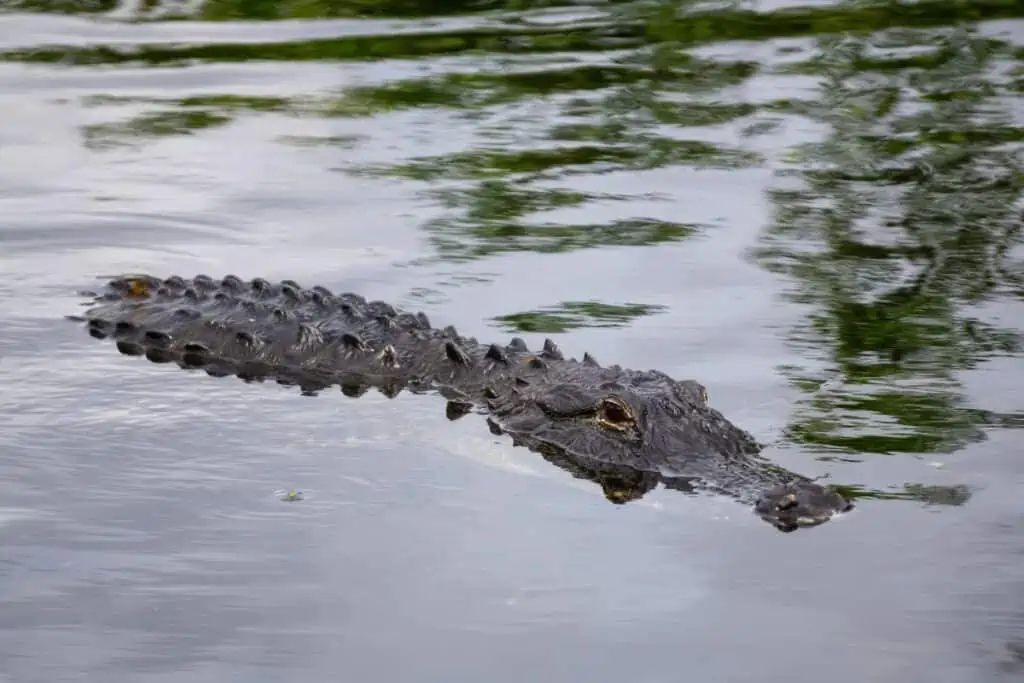As old as the dinosaurs, alligators (and other crocodilians) have remained relatively unchanged since their monstrous beginnings (why fix what is not broken?). Alligators are well adapted to a semi-aquatic lifestyle, spending most of their lives in and under the water, but how long can alligators hold their breath?
American alligators can hold their breath for around two hours when they remain stationary/less active and up to eight hours in cold conditions. Although alligators have the capacity for longer dives, they usually hold their breath for ten to twenty minutes while performing regular dives.
Let’s see how alligators (and other crocodilians) hold their breath for so long, the factors influencing their lung capacity, and why they need to hold their breath.

How Do Alligators Hold Their Breath For So Long?
American alligators (like all reptiles) are obligate air breathers. Although their lungs differ from those of mammals, they lack gills and need to frequently surface to gulp in some air (while exhaling the “stale” air) before submerging.
The reason why alligators can hold their lungs for a substantial time (the human world record is 24 minutes) is because of certain physiological adaptations:
- An alligator’s body “rations” the oxygen that it uses. An alligator’s body redirects air to essential organs to conserve its usage (some research suggests that only the heart receives oxygen).
- An alligator’s heart rate is much slower than a human. While diving, alligators’ heart rates drop to roughly 2 to 3 beats a minute.
- If an alligator needs to stay underwater for longer, it reduces its activity levels to conserve oxygen.
While alligators’ (and other crocodilians) physiological adaptations allow their bodies to maximize their breath-holding capacity, the way their bodies use this oxygen is fascinating.
Alligators use roughly half of the oxygen within the first 20 minutes, after which the body switches to a “conservation” mode for the remaining two hours. During this time, the alligator remains conscious.
Alligators suffer no ill effects when holding their breath for long periods. During a study in the 1960s, researchers discovered that the lactic acid (which developed during the dive) only appeared in the blood when the alligator exited the water, suggesting that oxygen to the muscles is limited.
Alligators have an iliocostalis muscle, which assists in regulating their breathing rates. As the alligator enters cooler water (around 64.4°F), this muscle ceases to assist respiration, which lowers the alligator’s respiratory rate.
Factors That Influence Lung Capacity
While alligators can hold their breath for two hours (and longer), the duration is influenced by certain factors and situations, including:
- The water temperature. Alligators hold their breath for longer in colder water as all bodily functions slow down (i.e., their metabolic rate slows, so they need less oxygen).
- The alligator’s activity levels. When an alligator remains submerged for up to two hours, their activity levels decrease, allowing their bodies to conserve oxygen.
- The alligator’s health, age, and size. Healthy, full-grown adults have a better lung capacity than sickly or juvenile animals.
Why Do Alligators Need To Hold Their Breath?
Crocodilians need to submerge for several reasons, including:
- Thermoregulation. The temperature underwater remains more constant than air temperatures.
When it’s hot, alligators head into the water to cool off. As the air temperature cools (toward winter), alligators head underwater to keep their body temperature constant.
- Hiding from predators and other dangers. Although alligators are the apex predators in a pond, there are other opportunistic predators.

Final Thoughts On Underwater Alligators
Alligators are well adapted to their semi-aquatic lifestyle.
While they can hold their breath for roughly 2 hours under “normal” conditions and up to 8 hours in cold conditions, alligators usually stay submerged for 10 to 20 minutes.
